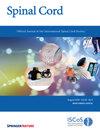颈脊髓损伤患者亚急性康复期间的手臂训练策略和治疗剂量维度:一项纵向观察研究。
IF 2.2
4区 医学
Q3 CLINICAL NEUROLOGY
引用次数: 0
摘要
研究设计:纵向观察研究。目的:探讨运动训练策略、治疗剂量和动机在颈脊髓损伤患者亚急性手臂-手康复中的作用及其在6个月康复期间的变化。环境:比利时和荷兰的三个康复中心。方法:在损伤后4-8周纳入C1-Th1和AIS A-D之间病变的个体,观察3周,间隔8周。定期进行至少25%的徒手训练。运动训练策略、治疗剂量和动机由两名训练有素的观察员、视频记录和患者报告的结果测量收集。结果:纳入了来自13名参与者(平均年龄54.4±12.9;C1-C5; AIS B-D)的240个疗程。分析训练显示手臂和手的活跃使用最高(30.3%),其次是技能训练(26.6%)。在15个面向任务的组件中,只有多个运动平面、功能运动和反馈在≥60%的会话中被使用。实际会话时间平均为计划持续时间的78.3%。在手挽着手阶段,52.1%的时间涉及到活动时间。技能训练的重复次数最少(MED: 66.5)。参与者报告低体力疲劳(4/10)和困难(4/10),但积极性高(7/10)。在六个月内观察到训练变量的有限变化。结论:我们的研究结果揭示了临床实践与基于证据的手臂训练指南之间的差距。尽管它很重要,但技能培训和关键任务导向的组成部分没有得到充分利用。与高动机相比,低感知难度和强度提示增加治疗剂量以获得更好的康复效果。本文章由计算机程序翻译,如有差异,请以英文原文为准。

Arm-hand training strategies and therapy dose dimensions during the subacute rehabilitation of people with cervical spinal cord injury: a longitudinal observational study
Longitudinal observational study. To explore motor training strategies, therapy dosage, and motivation in subacute arm-hand rehabilitation for individuals with cervical spinal cord injury and their change over a 6-month rehabilitation period. Three rehabilitation centers in Belgium and the Netherlands. Individuals with lesions between C1-Th1 and AIS A–D were included between 4–8 weeks post-injury and observed for three weeks with an eight-week interval. Regular arm-hand training sessions, with at least 25% arm-hand training, were analyzed. Motor training strategies, therapy dosage, and motivation were collected by two trained observers, video recordings and patient-reported outcome measures. 240 Sessions from thirteen participants (mean age 54.4 ± 12.9; C1-C5; AIS B–D) were included. Analytical training showed the highest active arm-hand use (30.3%), followed by skill training (26.6%). Of the 15 task-oriented components, only multiple movement planes, functional movements, and feedback were used in ≥60% of sessions. Actual session time averaged 78.3% of the planned duration. During the arm-hand session, 52.1% of the time involved active time. Skill training showed the lowest number of repetitions (MED: 66.5). Participants reported low physical fatigue (4/10) and difficulty (4/10) but high motivation (7/10). Limited changes in training variables were observed over six months. Our findings reveal a gap between clinical practice and evidence-based guidelines for arm-hand training. Despite its importance, skill training and key task-oriented components are underused. Low perceived difficulty and intensity, contrasted with high motivation, suggest the potential to increase therapy doses for better rehabilitation outcomes.
求助全文
通过发布文献求助,成功后即可免费获取论文全文。
去求助
来源期刊

Spinal cord
医学-临床神经学
CiteScore
4.50
自引率
9.10%
发文量
142
审稿时长
2 months
期刊介绍:
Spinal Cord is a specialised, international journal that has been publishing spinal cord related manuscripts since 1963. It appears monthly, online and in print, and accepts contributions on spinal cord anatomy, physiology, management of injury and disease, and the quality of life and life circumstances of people with a spinal cord injury. Spinal Cord is multi-disciplinary and publishes contributions across the entire spectrum of research ranging from basic science to applied clinical research. It focuses on high quality original research, systematic reviews and narrative reviews.
Spinal Cord''s sister journal Spinal Cord Series and Cases: Clinical Management in Spinal Cord Disorders publishes high quality case reports, small case series, pilot and retrospective studies perspectives, Pulse survey articles, Point-couterpoint articles, correspondences and book reviews. It specialises in material that addresses all aspects of life for persons with spinal cord injuries or disorders. For more information, please see the aims and scope of Spinal Cord Series and Cases.
 求助内容:
求助内容: 应助结果提醒方式:
应助结果提醒方式:


